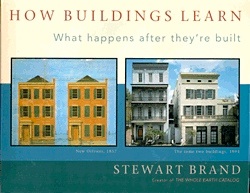How Buildings Learn
by Stewart Brand
Review By Dan Geddes
How Buildings Learn is an examination of buildings in time, as opposed to buildings as they are photographed for architectural magazines. Brand’s thesis is that buildings should be designed to accommodate future tenants and uses of the building. Contractors today design buildings only for the first tenant, condemning their work to later obsolescence.
Brand examines how people really use buildings. Some of the most cherished and reusable of buildings are “Low Road” buildings, where the tenants are able to alter the space in almost any way to further the task at hand. Old warehouses with their vast interior expanses are perennially adaptable. Artists are forever in search of Low Road buildings for their studios, but the resulting economic development often generates a cycle of real estate appreciation that results in expensive real estate in the once Low Road district.
In contrast, the “High Road” is best seen in styles like country estates. Here the emphasis is on building both for the ages, and for the personal needs of the owning family. Brand contrasts Mount Vernon, Montpellier, and Monticello, all homes built by three Founding Fathers from Virginia: Washington, Madison, and Jefferson. Separate wings were built at Madison’s Montpellier to house Madison’s family his parents. Jefferson’s Monticello suffered from Jefferson’s own estimation of himself as an amateur architect, striving for Palladian designs, compromised by his more personal needs. Monticello’s half-octagonal structure, its dome, its perilously narrow staircases are emblematic of a design that was intended to impress rather than to be comfortable to inhabit.
Jefferson’s desire to impress is often the goal of contemporary architects, who are designing for the architectural magazines. Brand notes that a chief problem within the profession is that awards are usually given on the basis of photographs of the building, that is, its appearance alone. Buildings are bound to be judged in terms of the architecture-cum-artist’s place within various styles and traditions. The building itself is not visited, nor its occupants or maintenance personnel asked how the building is to live in or work in. Notoriously, prize-winning buildings often prove to be shoddily constructed with leaking roofs and other defects.
The longevity of buildings is also threatened by the real estate market, which determines the profitability of maintaining buildings. Unforeseen changes in the local real estate market may force building management to either abandon or even demolish an otherwise functioning building. The shortsighted see only the “market value” of homes and properties, and fail to see their “use value.” Governments actually encourage the boom/bust cycle in real estate, though the booms are just as disruptive as the busts.
Brand’s thesis has major environmental repercussions, as many obsolete buildings are razed and their remnants deposited in landfills. The shoddiness of today’s designs leads to intense waste of time and energy. Architecture is a field in crisis, as architects are now schooled to design for “move-in” day, when photographs will be taken for magazines, rather than to build for the future. The life expectancy for new commercial buildings of any size is around 30 years–which is as long as the government gives tax incentives to the owners. Frequently, after that the building is torn down.
How Buildings Learn drives home its points through the use of photographs and drawings that illustrate the concept under discussion. One of the many joys of the book is viewing photographs of famous buildings, and reconsidering whether its design has stood the test of time.
Brand has done invaluable spadework in How Buildings Learn. He has sounded the alarm for foresight in building design. Builders of residential, commercial, and institutional structures can all learn lessons from this work. Our buildings are some of our greatest investments, and they demand our foresight.
December 2000






Be First to Comment